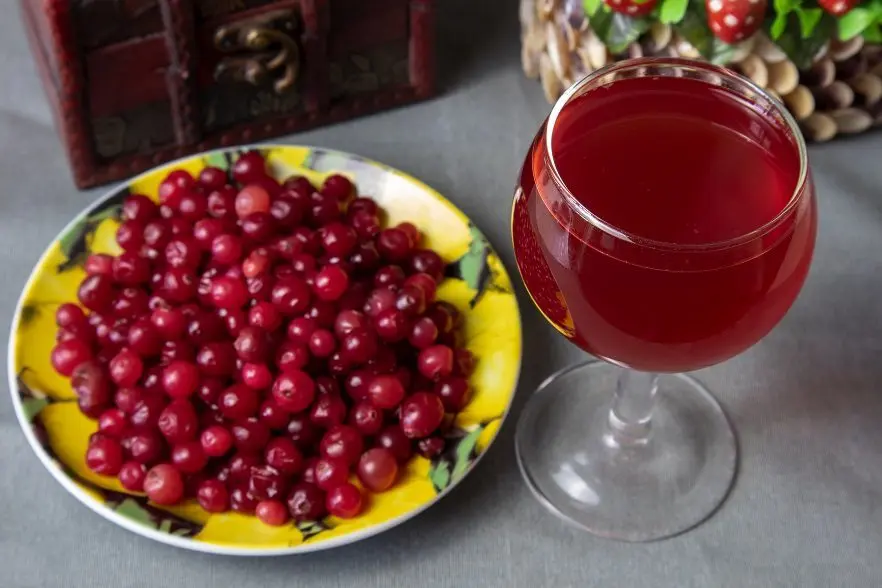Thanks to organic acids, trace elements and vitamins, homemade cranberry wine is not only tasty, but also healthy. True, it is not so easy to make it – cranberries are a very capricious berry that requires a special approach. We will consider the correct cooking technology that guarantees a positive result.
To make cranberry wine, you will have to add a lot of water and sugar. It’s all about the high acidity and low glucose content of the berries. It will not work to make wine on pure juice, the must will not even ferment.
For the needs of winemaking, it is better to harvest cranberries after the first frost, at which time the berries contain the maximum sugar. The fruits must be separated from the ridges and carefully sorted out, leaving only ripe ones. Even one spoiled berry can lead to mold. All containers used must also be perfectly clean – washed with boiling water, then wiped dry with a clean cloth.
Ingredients:
- cranberries – 5 kg;
- water – 5 liters;
- sugar – 5 kg.
cranberry wine recipe
1. Grind (mix) unwashed cranberries until smooth. On the surface of the berries live wild yeast, which is necessary for normal fermentation. If they are washed off, the wine may not ferment.
2. Pour the cranberry mass into a container with a wide neck, add 0,5 kg of sugar, pour water, mix well.
3. Bandage the neck with gauze, put the container for 5 days in a dark, warm (18-25 ° C) place. The first 3 days, once a day, mix the wort with a clean hand or a wooden stick. After 4-5 days, a “cap” of cranberry pulp forms on the surface.
4. Carefully remove the pulp. Strain the wort through 2-3 layers of gauze and pour into a fermentation tank (fill up to a maximum of 75% of the volume).
5. Squeeze the removed “cap” through gauze, add the liquid part to the main must, the pulp is no longer needed.
6. Add 2 kg of sugar to the future cranberry wine, mix well. Install a water seal or a medical rubber glove with a hole in the finger on the container. Seal all connections.

7. Move the container to a dark place with a temperature of 18-25°C.
8. After 4 days, add 1,5 kg of sugar. To do this, open the container with the wort, drain 1-2 liters separately, add sugar, mix well. Pour the resulting syrup back into the fermentation tank and install a water seal.
9. After 3 days, repeat the previous step, adding all the remaining sugar (1 kg) to the wine. Depending on the temperature and the activity of wild yeast, homemade cranberry wine ferments for 25-60 days.
If fermentation does not stop after 50 days from the date of installation of the water seal, the wort must be drained from the sediment through a tube into another container, then put under a water seal to ferment. If left on the lees for a long time, the wine can become bitter.
10. After fermentation is completed (a sediment has appeared at the bottom, the wine has brightened, the water seal does not blow bubbles for several days or the glove has deflated), pour the young wine through a thin tube into another container, trying not to touch the sediment at the bottom.
Taste the drink. You can additionally sweeten with sugar or fix with vodka (alcohol) – 2-15% of the volume. Fortified wine keeps better, but is tougher in taste and not as aromatic.
11. A container filled to the top (so that there is no contact with oxygen) tightly close with a cork and place for 3-6 months in a dark place with a temperature of 5-16 ° C. For example, in the refrigerator or basement.
Once every 15-20 days, when a sediment appears in a layer of 2-4 cm, filter the wine by pouring. Cooking is complete when sediment no longer appears.
12. Ready cranberry wine can be bottled or left in the same container. There is no fundamental difference. The result is 4-5 liters of rose-red cranberry wine with a strength of 10-12 degrees with a slightly tart taste. The aroma is weak. In the basement in hermetically sealed bottles, the drink can be stored for several years.










